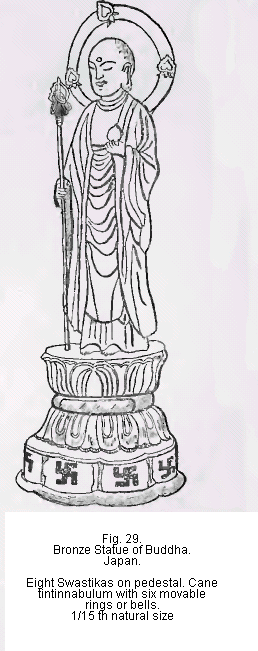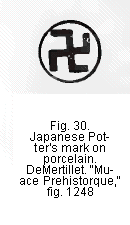

The Swastika
Dispersion of the Swastika
II. – Dispersion of the Swastika.
Extreme Orient
Japan
The Swastika was in use in Japan in ancient as well as modern times. Fig. 29
 represents
a bronze statue of Buddha, one fifteenth natural size. Form Japan, in
the collection of M. Ceruschi, Paris. It has eight Swastikas on the pedestal,
the ends all turned at right angles to the right. This specimen is shown
by De Mortillet (1) because
it relates to prehistoric man. The image or statue holds a cane in the
form of a “tintinnabulum,” with movable rings arranged to make a jingling
noise, and De Mortillet inserted it in his volume to show the likeness
of this work in Japan to a number of similar objects found in the Swiss
lake dwellings in the prehistoric age of bronze (p.806).
represents
a bronze statue of Buddha, one fifteenth natural size. Form Japan, in
the collection of M. Ceruschi, Paris. It has eight Swastikas on the pedestal,
the ends all turned at right angles to the right. This specimen is shown
by De Mortillet (1) because
it relates to prehistoric man. The image or statue holds a cane in the
form of a “tintinnabulum,” with movable rings arranged to make a jingling
noise, and De Mortillet inserted it in his volume to show the likeness
of this work in Japan to a number of similar objects found in the Swiss
lake dwellings in the prehistoric age of bronze (p.806).The Swastika mark was employed by the Japanese on their porcelain. Sir Augustus W. Franks (2) shows one of these marks, a small Swastika turned to the left and inclosed in a circle (fig. 30). Fig. 9 also represent a mark on Japanese bronzes. (3)
Korea
The U.S. national Museum has a ladies’ sedan or carrying chair from Korea. It bears eight Swastika marks, cut by stencil in the brass-bound corners, two on each corner, one looking each way. The Swastika is normal, with arms crossing at right angles, the ends bent at right angles and to the right. It is quite plain; the lines are all straight, heavy, of equal thickness, and the angles all at 90 degrees. In appearance it resembles the Swastika in fig. 9.

In the Chinese language the sign of the Swastika is pronounced wan (p. 801), and stands for “many,” “a great number,” “ten thousand,” “infinity,” and by a syneedoche is construed to mean “long
ENDNOTES:
1. “Musce Prehistorique,”fig. 1230; Bull. Soc. d’Anthrop., Paris pp. 299,313,314. [Back]
2. “Catalogue of Oriental Porcelain and Pottery,” pl. 11.fig. 139. [Back]
3. De Morgan, “Au Cancase,” fig. 180. [Back]
<< Previous Page Next Page >>
© 2004-2007 Northvegr.
Most of the material on this site is in the public domain. However, many people have worked very hard to bring these texts to you so if you do use the work, we would appreciate it if you could give credit to both the Northvegr site and to the individuals who worked to bring you these texts. A small number of texts are copyrighted and cannot be used without the author's permission. Any text that is copyrighted will have a clear notation of such on the main index page for that text. Inquiries can be sent to info@northvegr.org. Northvegr™ and the Northvegr symbol are trademarks and service marks of the Northvegr Foundation.

|